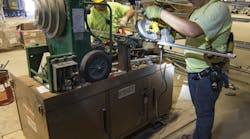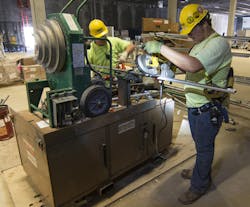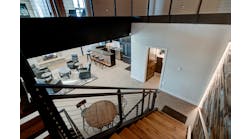Fast-Track Project Demands Labor-Saving Methods
After fire consumed a food processing plant in Manitoba, Canada, in March 2012, the owner was forced to quickly rebuild a new plant in another location. Glanbia Nutritionals Ingredient Technologies (GNIT) opted to construct a new 40,000-sq-ft facility in Sioux Falls, S.D.
From the beginning of the project, the construction team worked on a fast-paced schedule to get the new plant up and running. The structure broke ground in February 2013, and the construction team plans to wrap up the project this October.
Interstates, the Sioux Center, Iowa-based electrical contracting and engineering firm, is working alongside T.E. Ibberson, the general contractor, and Buehler Equipment, the process designer, to construct the cereal ingredient processing facility. Once completed, the 10-acre site will include office facilities, a warehouse, and a process tower.
Saving time in the field
Because the construction team was working on such a fast-track project, the contractors had to find innovative ways to improve productivity. Through its in-house prefabrication shop, Interstates was able to slash field installation time while staying on schedule. For example, the prefabrication shop made up 90° conduits rather than having all of its electricians bend the conduit in the field. By working from a 3D CAD model, the shop was able to bend much of the pipe, assemble conduit racks, and then deliver all the materials to the site.
“The electricians could just take the pipe to the electrical room and fit it together like a puzzle,” says Nate Van Kley, estimator for Interstates. “It saved a lot of time in the field.”
When they did need to bend conduit on-site, the electricians relied on what they call a “war wagon” (Photo 1). Built by the prefab shop, the gang box on wheels includes a conduit bender, pipe threader, tool box, drop board, oil bucket, and storage container. Jim Haack, project manager for Interstates, says the war wagons greatly simplify conduit bending compared to when he was working in the field.
“We used to have a bending and threading station, which was very difficult to move,” he says. “It would take a few electricians a few hours to transport it to another spot. Now that we have the war wagons, electricians can wheel them around to wherever they are working, carry them with a forklift, or hoist them to the upper floors with a crane.”
Another way Interstates saved time in the field was by prespooling wire. Interstates’ vendor supplied labeled wire and spooled them together on one reel. Instead of pulling individual wires, the electricians can simply pull all the conductors for a specific motor in one application. While prespooling saved time on the job, electricians were challenged by the fact that the majority of the electrical equipment came from overseas. As such, motors or control devices were metric, and Interstates required converters to make the connections. The engineering team had to calculate the proper conversions to size the wire and overcurrent protection appropriately — and then order the exact amount of wire for the motors and instruments.
“It’s been a challenge for our guys in the field because they’ve never had to deal with kilowatts instead of horsepower for motors,” Haack says. “Because it’s different and not what we’re used to, it generally takes a call to our engineering department to confirm we are using the right size of wire.”
Prewiring lighting fixtures
Another way the electricians saved a significant amount of time in the field was through rollout lighting. Instead of running conduit for each fixture, electricians installed the lighting junction boxes in the ceiling before the concrete was poured.
Most light fixtures feature a multi-tap ballast and are not hooked up for the proper voltage from the factory. To save time, Interstates had its prefab shop terminate the fixtures correctly, add the cone tops to each fixture, thread a piece of conduit out of the top, and then include a cover that can attach directly to the junction box in the ceiling. In the field, the electricians simply had to terminate the fixture inside the ceiling junction box and tighten the screws.
The mounting hardware for all the high-output fluorescent lighting fixtures at the warehouse was also installed at the pre-fab shop. By ordering lights with whips that plug into the light fixtures, the electricians didn’t need to terminate the lights because all the connections were made inside the junction box. Once the fixtures were on-site, they could simply be hung with the chain already included.
“No prewiring had to be done because it was all done at the shop,” Haack says. “We also didn’t have to take anything apart, and no connections had to be made.”
In addition, Interstates also equipped all the metal-halide and fluorescent lights in the warehouse with motion sensors. That way, the electricians only had to install two concrete anchors, plug it in, and then the fixture was done.
“If you had to do all that on-site, it would have doubled your field labor,” Haack says.
Working on a fast-track schedule
The construction team not only relied on prefabrication to improve productivity, but also employed innovative field methods to ensure cleanliness at the food-grade facility. For example, the electricians installed conduit within the concrete floors prior to them being poured. Each of the five floors in the process tower features an electrical enclosure, and the electricians also installed the conduit inside the walls (Photo 2) and into each of these enclosures. Then, they stubbed the conduit in different locations where the equipment was to be located, such as the electrical room on the second floor.
“We were able to eliminate most of the exposed conduit so there is no place for dust to settle,” Van Kley says. “That way, it is easier for maintenance and for cleaning.”
The in-the-slip conduit also saved a lot of time on the back end of the project. Traditionally, electricians need to wait until the floors are finished — and the equipment is installed — before the conduit can be put in place. On the Glanbia project, however, the majority of the conduit was already in place.
This time savings became especially important in the latter stages of the project. As a design-build job, the majority of the labor hours occurred in the last few months. As of late August, Interstates had only used about 50% of its labor hours, and to get the job done, the electrical contractor moved its electricians to six 10-hr work days a week.
“Our schedule is first and foremost the biggest challenge,” Haack says. “We have more people showing up on the job, and our crew is going to top out at around 25 electricians. With more field hands, it takes more supervision and more foremen.”
To keep everyone on task, project superintendents distribute task sheets every morning to crew members, and then give each electrician a goal for what they’d like to see completed by the end of the day. While working on the design-build project, the contractors (as well as the field workforce) had to all roll with the constant changes on the project.
“It was a very fast-paced schedule, and the design-build method allowed construction to begin well before all the details were clearly defined,” Van Kley says. “The team was willing to roll with the potential for changes in order to have Glanbia up and running as quickly as possible.”
Through partnering with its prefab shop, coming up with innovative work methods, and staying as organized as possible, Interstates was able to meet the challenges on this fast-track project and work with the other contractors to help GNIT rebuild for the future.
Fischbach is a freelance writer based in Overland Park, Kan. She can be reached at [email protected].





